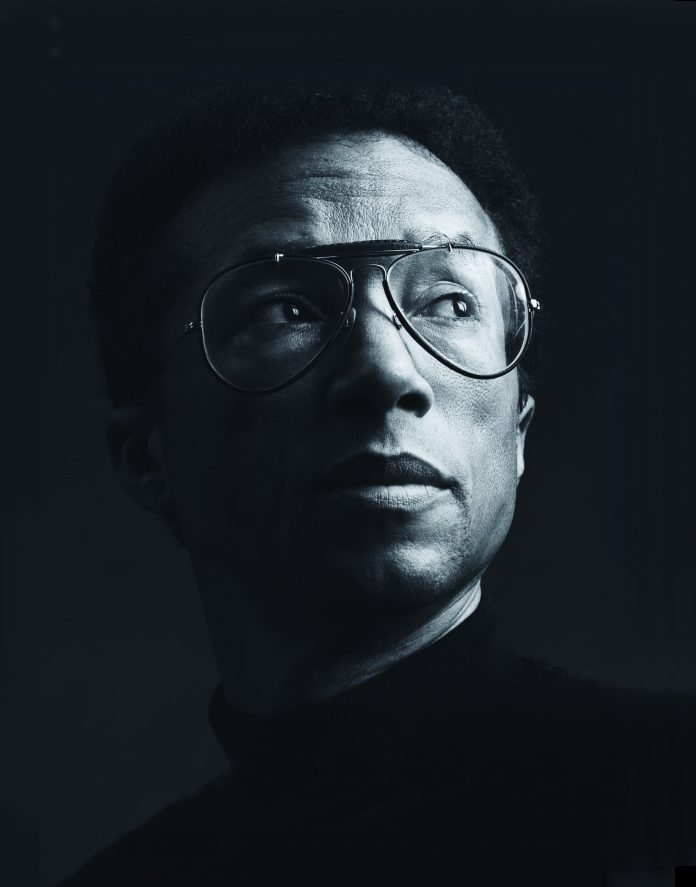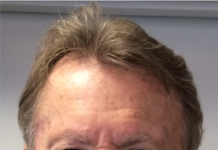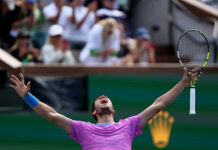The memory and meaning of tennis’s finest man
Bill Simons
Days are named for him. Children compose essays about his greatness. Thousands fill the stadium that bears his name. Statues sustain his memory. Organizations advance his vision. Now Raymond Arsenault has written a breathtaking new biography, Arthur Ashe: A Life, which brilliantly details Ashe’s genius and has been nominated for the Pulitzer Prize.
So, why do we still honor this lean man whose quiet demeanor led his pals to call him “the shadow,” the humanitarian athlete whose Davis Cup teammates dubbed him “our little militant”?
After all, Ashe, who battled the likes of Rod Laver, Bjorn Borg and John McEnroe, “only” won three Slams, was No. 1 for only a brief time and just manages to be ranked in the top 20 of the best players in tennis history. As writer Neil Amdur explains, “People cared because Ashe made everyone a part of his life. Rich. Poor. Old. Young. Black. White. Americans. Africans. South Africans. Europeans. Australians. He was as comfortable in a boardroom as a press room, a tennis court or a court of law, Wall Street and Main Street. Muhammad Ali, Pelé, Magic Johnson and Michael Jordan were the fiery comets in the sports galaxy, but Arthur Ashe was the guiding light.”
While the eloquent and fierce Martin Luther King was America’s visionary activist and an inspiring moral voice, some suggest that Ashe was the Martin Luther King of sports. Never has there been an elite male athlete who was so gifted, so curious, so insightful, so courageous, and so essentially good, and whose journey had so many fateful chapters. Who else played as many roles – victim and pioneer, athlete and commentator, ambassador and activist, No. 1 tennis player and No. 1 best-selling author, visionary and sage? He’s still the only African-American man to win a Slam.
Ashe lost his mother at six and was reared in Jim Crow Virginia with its humiliating cradle-to-grave racism. Like Jackie Robinson, Jimmy Connors, and Kareem Abdul-Jabbar, he went to UCLA in free-form Southern California to set the table for his stardom.
Arthur’s career was built on two landmark victories. In 1968, the most tumultuous year of our era, he won the first US Open. And his epic 1975 Wimbledon triumph can be viewed as a kind of morality play in which he was cast as an inventive hero who called on clever tactics to outwit the villain of the day – the then dominant, cocky Connors.
The first black man to make it in the white world of tennis, Ashe rose above the prejudice he’d endured and was a proud patriot. He had a glorious career as a Davis Cup player and captain, and went on to tirelessly combat racism, apartheid, AIDS, ignorance, illiteracy and medical malpractice.
His book, “Days of Grace,” and Andre Agassi’s “Open” are tennis’ two greatest autobiographies. Now, into tennis’ hall of fame of must-read books, we welcome “Arthur Ashe, A Life.” The beautifully written story of this imperfect, quixotic soul makes clear why Ashe still inspires, still illuminates and still matters in an era when many long for courageous and dignified voices of reason.
******
Ashe was a historian who embraced his African-American heritage. Yet the history of his own family had been obliterated. A cousin traced Arthur’s ancestry to a nameless slave woman who was sold at auction in 1735 to a tobacco planter. Ashe wrote, “I’ve tried to imagine her terror, rage, and fear…born free [she was] captured and transported to a strange and brutal world. I would like to think that she tried to escape…or that she joined one of the sporadic rebellions that were crushed harshly by masters who could not imagine that blacks were human beings. But along with her name, any record of rebellion…has been lost.”
Ashe faced many obstacles: the death of his mother, heart disease, brain surgery and AIDS. But he insisted that race was the key issue in his life. While he didn’t suffer grinding poverty, he faced the demeaning ills of segregation. Born on the cusp of the civil rights revolution, he outlived the cruelty of the Jim Crow South. But, writes Arsenault, “the indignities of his childhood and adolescence survived long enough to bruise his psyche…[In an era] of white supremacist and patriarchal ideology, the thought that a statue of Ashe, or anyone else of allegedly inferior stock, would ever grace the city’s most hallowed avenue was inconceivable.”
Arthur’s uncanny ability to overcome obstacles began early. The loss of his mother left an emptiness in his soul. Over the years, he would be shaped by many male mentors. His caring but stern and humorless father, who was consumed by the daunting task of providing for his family, could only offer limited emotional support and created a draconian world of unbending rules. Ashe recalled that if he forgot a chore, his dad would say, “Go get my belt.”…“Daddy expected top grades…I had to be home every day ‘immediately’ – which meant ten minutes, not eleven, after school let out…I never dared break [that rule].” Books and tennis were welcome antidotes for his melancholy.
Ashe’s tennis success would never have happened were it not for a critical intervention. Ten-year-old Arthur had been sent to a summer boot camp for black tennis wannabes that Dr. Robert Walter Johnson, “the Godfather of black tennis,” hosted in Lynchburg, Virginia. But once there, Ashe refused to alter his strokes. “Dr. Johnson wasted no time,” Arthur recalled. “He phoned my father. Daddy wasted no time either. He dropped everything and took the bus to Lynchburg…He told me, ‘If you don’t want to obey Dr. Johnson, come home.’” Arthur promptly became a model of obedience.
In an era when blacks would show up to play tourneys, only to be told, “Well, I’ll be damned. But you won’t play here, boy,” racism was a constant in Ashe’s life. Called a nigger, a pickaninny and a spade, Arthur was banned from many a site and tournament. Some country clubs allowed him to play, but then refused black spectators. At times he was thought to be a locker room attendant.
Arthur eventually left Richmond and made his way to a dazzling new world – Los Angeles. His father’s controls and the intimidation of segregation were now in his rearview mirror and he relished college life. UCLA was a lively haven blessed with heady, California-fresh ideas, fateful roommates (think Charlie Pasarell), fun-loving teammates and alluring women of all shades. In Virginia, blacks could be killed if they were seen with a white woman. At UCLA, Ashe dated a white co-ed whose mother told her daughter, “I don’t ever want him in my house, do you hear me?”
Yes, the times were tumultuous. But Arthur was cool. His father had insisted he never rock the boat. Dr. Johnson’s mantra had been, “Turn the other cheek.” Every ball hit close to a line must be called in your foe’s favor. Pick up the balls and hand them to your opponent. Subservience meant survival.
“We’re going into a new world. We’ve got to be extra careful,” cautioned Johnson. When Arthur was called names or told that a restaurant wouldn’t serve “your kind,” he just walked away, seemingly unruffled. “I don’t want to spend my life fuming,” he declared. “What good would that do? It’s like beating your head against a brick wall.”
As a powerful 6’1” collegiate star, Arthur won the 1965 NCAAs and became the first-ever African-American to be named to America’s Davis Cup team. Yes, at times his game could be erratic – his mind tended to drift. Still, his high-risk, high-reward game, with its athletic grace, drew accolades and powered him to 66 titles. A big star with a big game, he quipped that he was “as noticeable as the only raisin in a rice pudding.” He broke one barrier after another and was a vastly appealing young black champion – but he had a lot to lose if dared step out of place.
The patriotic Ashe gladly joined US State Department tours to Vietnam and Africa, where the message was clear: “Here’s an appealing Negro – things are just fine in the US.”
Not surprisingly, the risk-averse star who said he would be “proud to serve” in Vietnam, distanced himself from the “We shall overcome” ethos of the day. An Army lieutenant stationed at West Point, he contended, “By crusades and protest marches and rock-throwing, we seem to try to ram ourselves down people’s throats. Sometimes a demonstration is the best way of getting headlines…but I don’t think demonstrators should try to make trouble…We’ll never advance very far by force, because we’re outnumbered ten to one. Quiet negotiation and slow infiltration look more hopeful to me. Does this make me an Uncle Tom? If so, okay. I’m not the crusader type. I pay my $3 yearly dues to the NAACP and tend to my tennis.’”
But the winds of change were shifting – Birmingham bombs, napalm burns, the Tet Offensive, unfathomable assassinations, the Mexico City Olympics and the streets of Chicago. A generation asked, “Are you a part of the problem or part of the solution?” While his brother fought in Vietnam and he still heard his father’s conservative voice, Arthur began to wrestle with the conflicting narratives of the day.
He was an incessant analyst and a spot-on problem-solver. Kenny Moore noted that “when he turned his open, bespectacled, deceptively tranquil gaze upon an event or an argument, it got turned over and over in a blazing tungsten light.” Arsenault notes that Ashe’s conscience was now “ever more prodding, to the point where he could no longer turn away from perceived injustice. His days as a…self-absorbed athlete were over, and he now saw himself as a truth seeker.” He asked generals questions, was counseled by Martin Luther King, was quizzed on Meet the Press and Face the Nation, and gave controversial speeches. Among his great assets – fearsome serve, sublime backhand, adoration of family, kindness to friends, curious mind, wide-ranging intellect, dignity and courage – his greatest gift was his moral compass.
In 1969 he morphed into an activist, a humanitarian and a spiritual seeker. One headline read, “Negro Tennis Star Emerges from Shell.” Ashe admitted, “While blood was running freely in the streets of Birmingham, Memphis, and Biloxi, I had been playing tennis. Dressed in immaculate white, I was elegantly stroking tennis balls on perfectly paved courts…Meanwhile, across the South, young men and women were…suffering so that blacks would be free.” He added, “I felt a burning sense of shame that I was not with other blacks – and whites – standing up to the fire hoses and police dogs.” He came to realize that he hated injustice more than he loved decorum.
Arsenault writes, “He wanted to be a great and good man…[and] leave a legacy of independent vision and moral purpose that transcended sports. While tennis was the primary source of his celebrity, the pursuit of greatness on a much larger scale was the force that ultimately propelled his life.” Ashe was hardly an in-your-face insurgent. Essentially a gentleman rebel, he adeptly bypassed the treacherous currents of the contentious American civil rights and anti-war movements to focus on the seemingly futile effort to rid South Africa of apartheid.
He mused on the claim of his South African pal Ray Moore that he would never be allowed to play in the apartheid state and learned of the jailed warrior Nelson Mandela. Despite calls for an absolute boycott of South Africa, in 1973, two months after Billie Jean King’s Battle of the Sexes, Arthur decided to go on the first of his four trips to South Africa. To some, his headline-making visits undercut the movement to isolate the country. To others, he was a trailblazer. As South Africa’s first black sports hero, he integrated the South African Open, then the world’s sixth most important tennis tournament.
More importantly, Arthur touched hearts. Mark Mathabane, a teen from a shantytown, wrote, “The more I read about…Ashe’s role, the more I began to dream of its possibilities. What if I too were someday to attain the same fame and fortune as Arthur Ashe? Would whites respect me as they did him? Would I be as free as he?…His coming meant so much…[He triumphed] in a white man’s world…designed to sink blacks deeper into the mire of squalor…[I asked] how could a black man…trash a white man and be cheered by white people?”
Arsenault recounted that at a South African gala, when Arthur asked one of the servants for a cold drink, she dropped her eyes and said: “Yes, master.” Unnerved, Ashe reflected later: “So here is little Artie Ashe, the skinny black kid from the capital of the old Confederacy, all set up in a mansion, carrying on jes’ like white folks, and gettin’ himself called Master.” Then again, no one dealt with contradictions and conflict (black/white, radical/conservative, cool/square, his own calm/the rage of John McEnroe) with as much mastery.
While his early trips to South Africa were said to be instrumental in the two-decade process of dismantling apartheid, Ashe came to believe it was best to isolate South Africa. His work to initiate bans of the country inspired millions, including Mandela, who said Arthur was one of the people he most wanted to meet once he was freed from prison. For his part, Ashe wrote that Mandela emerging from jail without bitterness and then leading South Africa forward “may be the most extraordinary human achievement that I have witnessed.” When Ashe left South Africa, one black man said, “I see you…and it is a challenge to me to be like you, free, and if not me, my sons.” And poet Don Mattera snuck Ashe a poem entitled, “Anguished Spirit – Ashe.”
I listened deeply when you spoke
about the step-by-step evolution
of a gradual harvest
tendered by the rains of tolerance and patience.
Your youthful face a mask
hiding a pining, anguished spirit, and I loved you brother,
Not for your quiet philosophy
But for the rage in your soul.
Sadly, Ashe’s body would soon also rage, as he suffered three heart attacks, brain surgery and an AIDS-infected blood transfusion which began a long, painful descent. As Ashe fended off “an avalanche of deadly emotions,” he insisted that suicide was out of the question. “Despair is a state of mind to which I refuse to surrender.” He told himself, “You have to stop thinking of yourself as a victim and become a messenger.” Later he asserted, “I am a fortunate, blessed man. Aside from AIDS and heart disease, I have no problems.”
He wrote, “Pain has a purpose, I do not question its place in the universe or in [my] fate.” Ashe reasoned that if he asked, “Why me?” about his setbacks, then, “After I won Wimbledon, I should have asked ‘why me’ and doubted I deserved the victory…I do not brood on the prospect of dying soon. I am not afraid of death.”
As Arthur’s body weakened, his insights and impact soared. He accelerated his already extraordinary contributions to the advancement of tennis and to inner-city kids through his under-appreciated National Junior Tennis League. A zealous advocate for wisdom, he battled for higher standards in education. Similarly, he fought for worldwide AIDS awareness and a far more compassionate medical system. Seen as “an Ambassador for what is right,” he spoke at countless venues, including the UN, met three times with Mandela, and communicated with dignitaries.
While being a good golfing buddy, a caring husband and an adoring father (he confided that his favorite thing in life was watching his daughter navigate an ice cream cone), he wrote his fifth and sixth books. Five months before his death in 1993, he was honored at the US Open and arrested the next day at the White House for protesting the ill treatment of Haitian refugees.
No other sport has been blessed by so many who gave back or were such courageous pioneers – Billie Jean, Althea Gibson, Agassi, Martina, Federer, Roddick, Blake, Nadal and Andrea Jaeger all come to mind. But sports has never seen an explosion for good that has approached the nonstop surge Ashe made as his 49-year life drew to a close. No one visited the inner city more often or with more devotion. A prolific writer and an active TV commentator, he tirelessly attended conferences, lectured, protested and conducted clinics.
In other words, he was a one-man missionary – a gifted, doomed man doing all he could. He asserted, “True heroism is remarkably sober, undramatic. It is not the urge to surpass all others at whatever cost, but the urge to serve others at whatever cost.” He added, “The purest joy in life comes from helping others.”
Ashe’s remarkable campaign for good was based on his unwillingness to accept injustice and his deep spirituality. A Bible-studying Christian who also quoted the Koran and went to Buddhist temples, he celebrated the Jews who helped his career and “chose to dwell on the common areas shared by religions.” He was a disciple of Howard Thurman, a black San Francisco theologian who asserted, “Spirituality must be a dynamic force gathered and refined in solitude but applied in the world for the betterment of humanity.” Ashe practiced Thurman’s meditative process called “centering down.” which “brought one to a state of serenity.” Arthur agreed with Martin Luther King, who suggested that blacks “might eventually prove to be the agents through which America redeems itself.”
“If I had one last wish,” Ashe wrote, “I would ask that all Americans could see past the barbed wires of race and color. We are the weaker for these divisions, and the stronger when we transcend them.” Of course, questions linger. Why do such terrible things happen to such good people? What would he think of tennis, where financial guarantees are now embedded, the Davis Cup has been diminished and, for all the success of the Williams sisters, no African-American male has won a Slam since he did in 1975? Had he lived, what would this calm sage, who considered running for Congress, have accomplished? Would he have become a senator or an ambassador? What would have been his impact? Does our need for heroes lead us to idolize the man too much? And, were he alive, what would he think of our society now?
In these days of bluster and bravado, when humility is rare and truth-telling is sparse, Ashe’s legacy of quiet truthfulness shouts loud. It’s his quiet wisdom we hear.
Former senator Bill Bradley reminded us, “Arthur was not loud. He didn’t boast. He thought before he spoke. Like a good poet, he used silence to his advantage. He held back until he was ready and that restraint was a strength.”
His good pal Charlie Pasarell asserted that Ashe “was the most courageous man I ever knew…He used dignity and restraint as weapons against opponents, whether childish tennis players or the cruel purveyors of racism. With his poker-faced courage, he stared down social injustice, three heart attacks and AIDS, and became a conscience for a nation.”
Arsenault notes, “Ashe suffered many defeats, including a cruel and untimely death. Yet he was undefeated in the realms that mattered most – heart, soul, integrity, and character. In this important sense, there is no shadow to darken his legacy. What remains is the radiance of a good and great man whose inner light shines outward for all to see.”



















